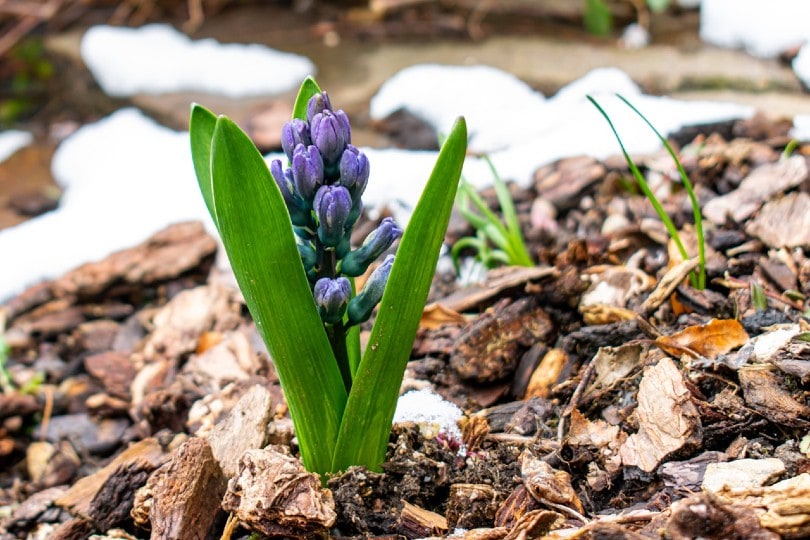How & When to Plant Hyacinth: 4 Simple Steps
-
Shea Cummings
- Last updated:

Originally from Europe, the Hyacinth plant had over 2,000 cultivars at one point. Now, there are around 60 commercially-cultivated varieties to choose from, and it’s one of the easiest spring bulb perennials to grow. Garden, containers, or even a bulb vase filled with water are all suitable for growing Hyacinth.
One of the biggest pros(and cons) is the Hyacinth’s strong aroma. Some people love how strong and fragrant the flowers are, but others are a little overwhelmed by the smell. Whether you like the smell or not, it’s hard to ignore the beauty of a group of Hyacinth plants in bloom.
If you live in a climate where temperatures get chilly in the fall and winter, Hyacinths are easy to grow. This guide will give you the information you need on how and when to plant them. And a few tips for ongoing care.
 When to Plant Hyacinth
When to Plant Hyacinth
If you want spring-blooming Hyacinth, you’ll want to plant the bulbs approximately 1–2 months before the first frost of the fall. This typically ends up being somewhere between September and October in most places.
Unlike many other plants out there that need warmth, sun, and water to sprout, Hyacinth bulbs are the opposite. The bulbs need cooler temperatures to sprout. So, unless you live somewhere where the winter temperatures drop to the 30s regularly, you’ll need to purchase pre-chilled bulbs for successful growing.

The4 Steps on How to Plant Hyacinth
1. Choose Your Bulbs and Area
When you’re getting ready to plant, choose healthy bulbs. Your best bet is the large bulbs that show no signs of decaying or diseases.
Also, you’ll want to choose the area where you’re planting the bulbs. For the best fragrance, plan for multiple bulbs to be planted in one area. And because they thrive in full sun or partial sun, you’ll want to plant them somewhere that receives at least 6 hours of sunlight a day. The more sun, the better.
2. Prepare the Soil

If the soil is high-quality and nutrient-rich, there isn’t much to do for prep. However, if the soil isn’t great, mixing in a 5-5-10 slow-release plant food prior to planting the bulbs will help. Once you do this, your bulbs will require little to know care until the spring.
3. Planting
There’s no specific depth that you must plant a Hyacinth bulb. Essentially, the size of the bulb determines the depth because you want to plant them approximately 3–4 times deep as they are tall.
4. Enjoy the Plant

Once the bulbs are in the ground, it’s time to let nature do its job. Over the winter, the chill will prepare the bulbs for sprouting in the spring. When spring hits and the plant begins to sprout, give the soil a bit of fertilizer.
 Things to Remember When Planting Hyacinth
Things to Remember When Planting Hyacinth
Hyacinth plants aren’t difficult to grow, but there are a few things to keep in mind when planting them to offer them the best chance of growing:
- Don’t overwater the bulbs because they are susceptible to root rot.
- Once the flowers bloom, leave the leaves on the plant because it provides nutrients for the following year’s blooms. If you take the leaves off, the plant will never bloom again.
- You don’t need to go crazy with the fertilizing—twice a year is fine.
Looking After Hyacinth
Hyacinths don’t require a lot of ongoing maintenance. But there are a few things to keep in mind when caring for them.
Water
They don’t need a lot of water. You want the soil to dry in between waterings. Depending on your climate, you should only need to water them once or twice a week. Hyacinths don’t like sitting in wet soil. This is why it’s so important that the soil is loose and drains well.

Temperature
Hyacinths are pretty hardy and do well in USDA zones 4–8. Depending on where you live, you may need to protect the dormant bulbs over the winter, but they don’t require anything special in most cases.
- If the bulbs are overwatered in poor-draining soil, they are susceptible to bulb rot.
- Another common issue with your Hyacinth is gray mold, which typically starts with too much moisture. If any plants are infected, remove them right away and spray the remaining ones with an herbicide to prevent the mold’s spread.
- Sometimes slugs can be a nuisance for these plants, but most other pests avoid them.

Popular Hyacinth Varieties
There are around 60 cultivars to choose from, but here are some of the most common varieties for the home gardener:
- China Pink: The beautiful blooms on this Hyacinth are a pale pink color with dashes of hot pink through the flower.
- Peter Stuyvesant: If you’re looking for something that starts blooming early, the wonderful blue-purple flowers of this Hyacinth won’t disappoint.
- Gypsy Queen: This is a relatively old cultivar that dates back to around 1927. Its flowers are salmon pink.
- Top White: This variety has white, star-shaped blooms if you’re looking for some white for the garden
 Closing Thoughts
Closing Thoughts
Hyacinth plants will make a great addition to your cold climate garden. Unlike many other plants, these thrive from the cold weather over the winter. When taking care of a Hyacinth once it sprouts, the main thing is to let it dry out between watering, so the bulb doesn’t stay wet.
Featured Image Credit: Coernl, Pixabay
Contents
 When to Plant Hyacinth
When to Plant Hyacinth Things to Remember When Planting Hyacinth
Things to Remember When Planting Hyacinth